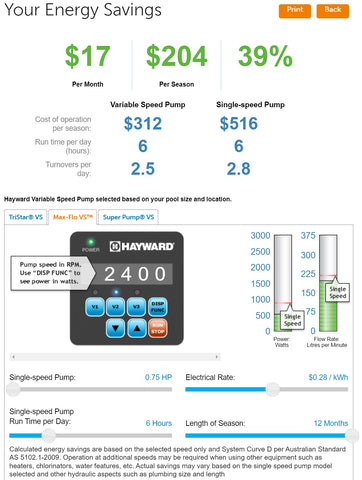Complete Guide to Variable Speed Pumps VS. Single Speed Pool Pumps
When it comes to swimming pool maintenance, one essential component that often takes the spotlight is the pool pump. It’s the heart of your pool's circulation system, pulling water from your pool, filtering it, and then sending it back. Over the past few years, the technology behind pool pumps has evolved tremendously. Now, homeowners are presented with a decision: Should they invest in a variable speed pump or stick with a traditional single speed pool pump?
Let's break down the differences, advantages, and potential drawbacks of each type.
1. Basic Functionality:
-
Single Speed Pumps: As the name suggests, these pumps operate at one consistent speed. Once you turn it on, it runs at its maximum horsepower until you shut it off.
-
Variable Speed Pumps: These pumps can operate at different speeds, allowing you to adjust the flow rate as needed. They use a different kind of motor technology known as a permanent magnet motor, similar to those in electric cars.
2. Energy Efficiency & Cost:
It's worth understanding that almost 20% of a household's power consumption, goes to the operation of their pool pump.
-
Single Speed Pumps: They tend to consume more energy because they always run at full power. Over time, the consistent energy consumption can lead to higher electricity bills.
-
Variable Speed Pumps: By adjusting the speed, they only use the energy necessary for the task at hand. For instance, filtering requires less power than running a pool cleaner. According to studies, variable speed pumps can save up to 90% in electrical cost savings over single speed pumps.
Below: Hayward VS pump operating at Mid speed (comparable in performance to a single speed 0.75hp pump)
Below: Hayward VS pump operating at Low speed (achieving 2x water turnover with 8 hours per day).
3. Noise Levels:
-
Single Speed Pumps: Typically louder due to the constant high-speed operation.
-
Variable Speed Pumps: Typically much quieter, especially when operating at lower speeds. Some are so quite you can't even hear them over the rushing water through the pipework.
4. Lifespan & Durability:
-
Single Speed Pumps: They can wear out faster due to the continuous high-speed operation.
-
Variable Speed Pumps: Often last longer because they can operate at lower speeds, reducing wear and tear.
5. Price Point:
-
Single Speed Pumps: Generally cheaper upfront.
-
Variable Speed Pumps: More expensive initially but can offer savings in the long run due to reduced energy costs.
6. Environmental Impact:
-
Single Speed Pumps: Higher energy consumption equates to a larger carbon footprint.
-
Variable Speed Pumps: Their energy efficiency not only saves you money but also contributes to a smaller carbon footprint.
7. Flexibility & Control:
-
Single Speed Pumps: Limited flexibility; it's either on or off.
-
Variable Speed Pumps: Allow for more precise control over your pool’s circulation, filtration, and other tasks, such as water features or spa jets.
Which is Right for You?
Your decision will largely depend on your priorities:
- If you're looking for an affordable upfront cost and have a smaller pool, a single-speed pump might suffice.
- If you're interested in long-term savings, quieter operation, and greater control, investing in a variable speed pump would be beneficial.
However, do note that legislation is pushing for the adoption of energy-efficient pool equipment, which might further influence your decision. Knowing pool registration is currently a major focus of governments, future proofing your pool could be a better financial decision.
Below is an excert from the GEMS Regulator for Australian pools:
"Overview
New mandatory energy efficiency standards and labelling requirements are being introduced for swimming pool pumps sold in Australia.
These requirements are being introduced under the Greenhouse and Energy Minimum Standards (GEMS) Act 2012 which regulates energy efciency and labelling standards for equipment and appliances in Australia.
How will GEMS rules apply to pool pumps?
From 1 October 2022 pool pumps regulated under the GEMS Act and ofered or available for sale in Australia will need to be registered with the GEMS Regulator and display the appropriate energy rating label.
What are the benefts of this change?
More efcient pool pumps will help Australian pool owners save money on their energy bills while reducing greenhouse gas emissions.
The regulations will remove the least efcient pool pumps from the market and help pool builders, retailers and other professionals provide advice to consumers on the most energy efcient pump available for their pool. "
Check out more on the current focus and legislation here: https://www.energyrating.gov.au/industry-information/publications?field_product_target_id=41
Conclusion:
Both single speed and variable speed pool pumps have their merits. As pool technology continues to advance, it's essential to stay informed about the available options. By understanding the benefits and potential drawbacks of each type, you can make an informed decision that's best for your pool, wallet, and the environment.



